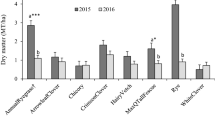Abstract
Demand for goat (Capra hircus) meat in the southeastern USA is steadily increasing as a result of preferences exhibited by ethnic communities. Feeding systems that include fodder trees can be developed to take advantage of the natural preference of goats for browse. Data were collected for 2 years on a 5-year old stand of Robinia pseudoacacia L. to evaluate growth characteristics for goat browse and to develop allometric relationships in a randomized complete block design (intra-row spacing 0.5 or 1 m and coppice height 0.25 or 0.50 m) replicated six times. Allometric equations were derived from destructive harvests of 68 trees. Main branch size was not affected by intra-row spacing when trees were coppiced at 0.25 m; however, when coppiced at 0.5 m, trees spaced at 1 m had more and larger branches (P < 0.05) than trees spaced at 0.5 m. Intra-row spacing did not influence tree herbage biomass when trees were spaced at 0.5 m whereas trees coppiced at 0.25 m and spaced at 1 m produced less woody and herbaceous biomass than trees spaced at 0.5 m (P < 0.05). A strong relationship (P < 0.0001) was found between tree herbage biomass and the number of main branches greater than 0.01 m (r 2 = 0.80). The results, based on growth characteristics and tree herbage biomass production, suggest that Robinia pseudoacacia L. would be an excellent candidate as a silvopastoral component in the southeastern USA.







Similar content being viewed by others
References
Addlestone BJ (1996) Density and cutting height effects on the herbage mass of three tree legumes grown for meat goat production. MS thesis. North Carolina State University
Addlestone BJ, Mueller JP, Luginbuhl JM (1999) The establishment and early growth of three leguminous tree species for use in silvo-pastoral systems of the southeastern USA. Agroforest Syst 44:253–265
Ainalis AB, Tsiouvaras CN (1998) Forage production of woody fodder species and herbaceous vegetation in a silvopastoral system in Northern Greece. Agroforest Syst 42:1–11
Association of Offical Agricultural Chemists (1999) International official methods of analysis. 16th edn. AOAC, Arlington
Ayers AC, Barrett RP, Cheeke PR (1996) Feeding value of tree leaves (hybrid popular and black locust) evaluated with sheep, goats, and rabbits. Anim Feed Sci Technol 57:51–62
Boring LR (1982) The role of black locust (Robinia pseudoacacia L.) in forest regeneration and nitrogen fixation in the Southern Appalachians. PhD dissertation, University of Georgia
Boring LR, Monk CD, Swank WT (1981) Early regeneration of a clear-coppiced southern Appalachian forest. J Ecol 62:1244–1253
Boring LR, Swank WT (1986) Hardwood biomass and net primary production following clear-cutting in the Coweeta Basin. In: Brooks RT Jr (ed) Proceedings of the 1986 southern forest biomass workshop, Tennessee Valley Authority, 1986
Cheeke PR (1998) Natural toxicants in feeds, forages and poisonous plants. Interstate Publishers, Danville
Converse TE, Betters DR (1995) Biomass yield equations for short rotation black locust plantations in the central Great Plains. Biom Bioeng 8(4):251–254
Crow TR (1983) Comparing biomass regression by site and stand age for red maple. Can J For Res 13:283–288
Goering HK, Van Soest PK (1970) Forage fiber analyses (apparatus reagents, procedures and some applications). Agric Handb 379 Agric Res Serv USDA Gov Print Office, Washington
Holden LA (1999) Comparison of methods of in vitro dry matter digestibility for ten feeds. J Dairy Sci 82:1791–1794
Horton GMJ, Christensen DA (1981) Nutritional value of black locust tree leaf meal (Robinia psudeoacacia) and alfalfa meal. Can J Anim Sci 61(2):503–506
Komarek AR, Robertson JB, Van Soest JB (1994) Comparison of the filter bag technique to conventional filtration in the Van Soest Analysis of 21 feeds. In: Proceedings of the national conference on forage quality, evaluation and utilization, Lincoln
Luginbuhl JM, Green JT, Mueller JP, Poore MH (1996) Meat goats in land and forage management. In: Proceedings of the Southeast regional meat goat production symposium, meat goat production in the southeast—today and tomorrow, Florida A and M University, Tallahassee, 21–24 February
Luginbuhl JM (2006) Meat goat production in North Carolina. North Carolina State University Cooperative Extension Fact Sheet
National Research Council (NRC) (1981) Nutrient requirements for goats. National Academy Press, Washington
Natural Research Conservation Service (2006) Soil Survey Staff, United States Department of Agriculture. Official soil series descriptions [Online WWW]. Available URL: “http://www.soils.usda.gov/technical/classification/osd/index.html” (Accessed 10 May 2006)
North Carolina State University (2003) State climate office of NC. http://www.nc-climate.ncsu.edu. Cited 20 March 2003
Papachristou TG, Platis PD, Papanastasis VP, Tsiouvaras CN (1999) Use of deciduous woody species as a diet supplement for goat grazing Mediterranean shrublands during the dry season. Anim Feed Sci Technol 80:267–279
Papanastasis VP, Panagiotis DP, Dini-Papanastasi O (1998) Effects of age and frequency of coppice on productivity of Mediterranean deciduous fodder tree and shrub plantations. For Ecol Manage 110:283–292
Papanastasis VP, Platis PD, Dini-Papanastasi O (1997) Productivity of deciduous woody and fodder species in relation to air temperature and precipitation in a Mediterranean environment. Agrofor Syst 37:187–198
SAS (2002) The SAS system for windows. Release 8.03. SAS Institute, Cary
Swank WT, Schreuder HT (1974) Comparison of three methods of estimating surface area and biomass for a forest of young eastern white pines. Forest Sci 20:91–100
Unruh LJ, Luginbuhl JM, Mueller JP, Conrad AP, Turner KE (2007) Intake, digestibility and nitrogen utilization of Robinia pseudoacacia foliage fed to growing goat wethers. Small Rumin Res (in press)
USDA Department of Agriculture (2006) National Agricultural Statistics Service. http://www.nass.usda.gov:8080/QuickStats/PullData_US.jsp
Van Soest PJ, Robertson JB, Lewis BA (1991) Methods for dietary fiber, neutral detergent fiber, and nonstarch polysaccharides in relation to animal nutrition. J Dairy Sci 74:3583–3597
Acknowledgements
The authors would like to thank Tom Wentworth, Brian Fouts, Amy Conrad, and John Mueller and those who volunteered to endure the endless summer days of hand defoliating BL.
Author information
Authors and Affiliations
Corresponding author
Rights and permissions
About this article
Cite this article
Unruh Snyder, L.J., Mueller, J.P., Luginbuhl, J.M. et al. Growth characteristics and allometry of Robinia pseudoacacia as a silvopastoral system component. Agroforest Syst 70, 41–51 (2007). https://doi.org/10.1007/s10457-007-9035-z
Published:
Issue Date:
DOI: https://doi.org/10.1007/s10457-007-9035-z




